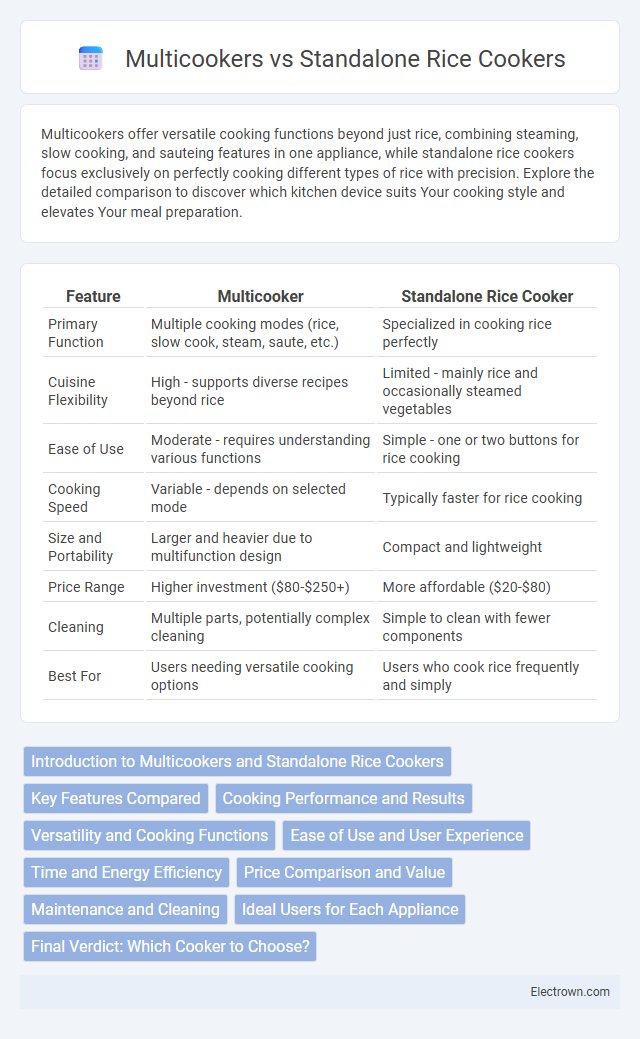Multicookers offer versatile cooking functions beyond just rice, combining steaming, slow cooking, and sauteing features in one appliance, while standalone rice cookers focus exclusively on perfectly cooking different types of rice with precision. Explore the detailed comparison to discover which kitchen device suits Your cooking style and elevates Your meal preparation.
Table of Comparison
| Feature | Multicooker | Standalone Rice Cooker |
|---|---|---|
| Primary Function | Multiple cooking modes (rice, slow cook, steam, saute, etc.) | Specialized in cooking rice perfectly |
| Cuisine Flexibility | High - supports diverse recipes beyond rice | Limited - mainly rice and occasionally steamed vegetables |
| Ease of Use | Moderate - requires understanding various functions | Simple - one or two buttons for rice cooking |
| Cooking Speed | Variable - depends on selected mode | Typically faster for rice cooking |
| Size and Portability | Larger and heavier due to multifunction design | Compact and lightweight |
| Price Range | Higher investment ($80-$250+) | More affordable ($20-$80) |
| Cleaning | Multiple parts, potentially complex cleaning | Simple to clean with fewer components |
| Best For | Users needing versatile cooking options | Users who cook rice frequently and simply |
Introduction to Multicookers and Standalone Rice Cookers
Multicookers offer versatile cooking options beyond rice, including steaming, slow cooking, and sauteing, making them ideal for multitasking in the kitchen. Standalone rice cookers specialize in perfecting rice textures with precise temperature control and consistent results, often featuring simpler interfaces. Your choice depends on whether you prefer a multifunctional appliance or a dedicated rice cooker for optimized rice preparation.
Key Features Compared
Multicookers combine versatility with programmable settings, offering functions like slow cooking, steaming, sauteing, and pressure cooking, whereas standalone rice cookers focus primarily on precise rice cooking modes with specialized fuzzy logic technology for optimal texture. Multicookers typically include digital interfaces and customizable recipes, providing multi-functional meal preparation, while standalone rice cookers emphasize simplicity and consistent rice cooking results, often with dedicated settings for different rice types. Capacity, ease of cleaning, and energy efficiency vary, with multicookers generally requiring more power due to advanced features, contrasted with the streamlined operation and affordability of standalone rice cookers designed solely for rice preparation.
Cooking Performance and Results
Multicookers offer versatile cooking performance, allowing you to prepare a wide range of dishes with adjustable settings for precise temperature and time control, which can enhance texture and flavor. Standalone rice cookers specialize in consistently producing perfectly cooked rice with optimized steam and heat distribution, ensuring fluffy grains every time. Your choice depends on whether you prioritize multi-functionality or specific excellence in rice cooking results.
Versatility and Cooking Functions
Multicookers offer extensive versatility with multiple cooking functions such as slow cooking, steaming, sauteing, and baking, allowing you to prepare a variety of meals beyond rice. Standalone rice cookers specialize in cooking rice perfectly with dedicated settings but lack the multifunctionality of multicookers. Choosing a multicooker enhances your kitchen efficiency by combining various appliances into one, while rice cookers provide simplicity and precision for cooking rice.
Ease of Use and User Experience
Multicookers offer greater versatility with multiple cooking functions but can present a steeper learning curve due to complex controls and settings. Standalone rice cookers provide a straightforward, user-friendly interface optimized specifically for perfect rice preparation, making them ideal for users prioritizing simplicity and consistent results. Your choice depends on whether you value multifunctional convenience or a dedicated, hassle-free rice cooking experience.
Time and Energy Efficiency
Multicookers offer superior time and energy efficiency compared to standalone rice cookers by combining multiple cooking functions into one appliance, reducing the need for additional devices and minimizing overall electricity consumption. Their advanced technology often includes faster cooking cycles and smart heat control, ensuring your meals cook evenly and quickly while using less power. Choosing a multicooker can optimize your kitchen's energy use without compromising the quality or speed of your rice preparation.
Price Comparison and Value
Multicookers typically come at a higher price point than standalone rice cookers due to their multifunctional features, allowing you to steam, slow cook, and saute beyond just cooking rice. While standalone rice cookers are more affordable and efficient for cooking rice alone, multicookers offer greater value by combining multiple appliances into one device, saving countertop space and reducing the need for additional kitchen gadgets. Your choice depends on whether you prioritize budget-friendly simplicity or versatile functionality in your kitchen appliances.
Maintenance and Cleaning
Multicookers require more intensive maintenance due to their complex components, including multiple cooking modes and sealing rings that must be thoroughly cleaned to prevent residue build-up and odor. Standalone rice cookers generally feature simpler designs with fewer parts, making them easier to disassemble, clean, and maintain regularly. Proper cleaning of both devices extends their lifespan, but standalone rice cookers typically demand less time and effort for routine upkeep.
Ideal Users for Each Appliance
Multicookers are ideal for users seeking versatile kitchen appliances capable of pressure cooking, slow cooking, steaming, and baking, making them perfect for households with diverse cooking needs and limited counter space. Standalone rice cookers suit those who prioritize consistently perfect rice with minimal effort, especially in families or individuals who frequently consume rice as a staple. Your choice depends on whether you value multifunctionality or specialized simplicity in preparing rice.
Final Verdict: Which Cooker to Choose?
Multicookers offer versatile functionality, allowing you to prepare a variety of dishes beyond just rice, such as stews, soups, and yogurt, making them ideal for those seeking an all-in-one appliance. Standalone rice cookers, on the other hand, provide precision cooking specifically designed to produce perfect rice consistently with minimal effort. Your choice depends on whether you value multi-purpose versatility or dedicated, specialized rice cooking performance.
Multicookers vs Standalone Rice Cookers Infographic

 electrown.com
electrown.com